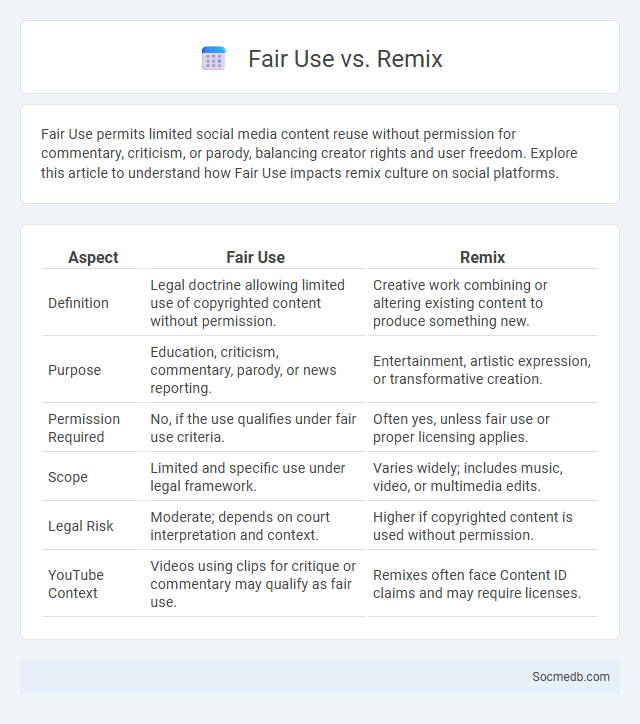
Photo illustration: Fair Use vs Remix
Fair Use permits limited social media content reuse without permission for commentary, criticism, or parody, balancing creator rights and user freedom. Explore this article to understand how Fair Use impacts remix culture on social platforms.
Table of Comparison
| Aspect | Fair Use | Remix |
|---|---|---|
| Definition | Legal doctrine allowing limited use of copyrighted content without permission. | Creative work combining or altering existing content to produce something new. |
| Purpose | Education, criticism, commentary, parody, or news reporting. | Entertainment, artistic expression, or transformative creation. |
| Permission Required | No, if the use qualifies under fair use criteria. | Often yes, unless fair use or proper licensing applies. |
| Scope | Limited and specific use under legal framework. | Varies widely; includes music, video, or multimedia edits. |
| Legal Risk | Moderate; depends on court interpretation and context. | Higher if copyrighted content is used without permission. |
| YouTube Context | Videos using clips for critique or commentary may qualify as fair use. | Remixes often face Content ID claims and may require licenses. |
Understanding Fair Use: Legal Foundations
Fair use is a crucial legal principle that allows limited use of copyrighted content without permission, ensuring your social media posts comply with copyright law. Understanding the four key factors--purpose, nature, amount, and effect on the market--helps you determine when content sharing is legally protected. Staying informed about these foundations safeguards your social media presence from infringement claims and supports responsible content creation.
Defining Remix: Creative Transformation
Remix in social media involves creatively transforming existing content to produce new, original expressions that resonate with diverse audiences. This process leverages digital tools to manipulate text, images, videos, or audio, enabling you to personalize and amplify your message. By defining remix as a dynamic act of innovation, social media users enhance engagement and foster cultural exchange.
Fair Use vs Remix: Core Differences
Fair Use allows you to legally use copyrighted content under specific conditions such as commentary, criticism, or education without permission. Remix involves creatively transforming or combining existing media to produce new, original content, which may require permission unless it qualifies as Fair Use. Understanding the core differences helps you navigate legal boundaries on social media while respecting intellectual property rights.
Legal Criteria for Fair Use
Fair use criteria in social media include evaluating the purpose and character of your content, especially whether it is transformative or for commercial use. Courts also consider the nature of the original work, the amount of content used, and the effect on the market value of the original. Adhering to these legal standards helps ensure your social media posts respect copyright laws while leveraging protected material.
How Remixes Navigate Copyright Laws
Remixes operate in a complex legal landscape shaped by copyright laws, often relying on fair use provisions that consider factors such as transformation, purpose, and market impact. Platforms implement automated content recognition systems like Content ID on YouTube to manage copyrighted material while allowing creators to share remixed content legally. Navigating these laws requires understanding licensing agreements and sometimes obtaining permission or licenses to avoid infringement claims and enable lawful distribution.
Common Misconceptions about Fair Use
Common misconceptions about fair use on social media include the belief that any content shared for non-commercial purposes is automatically protected, which is inaccurate because fair use depends on factors like purpose, nature, amount used, and market effect. Many assume that simply crediting the original creator grants fair use, but acknowledgment alone does not exempt you from copyright infringement. Understanding these nuances helps protect your social media content while respecting intellectual property rights.
Examples: Notable Fair Use vs Remix Cases
Notable fair use cases involving social media include the 2013 case of *Lenz v. Universal Music Corp.*, where the court ruled that the use of a short music clip in a home video posted on Facebook could qualify as fair use, emphasizing the importance of considering context and purpose. Another significant example is *Cariou v. Prince* (2013), where the court upheld the fair use defense for Patrick Cariou's photographs used in appropriation artworks shared widely online. These cases highlight how transformative use and minimal market impact are key factors in determining fair use on social media platforms.
Risks and Challenges for Creators
Social media creators face significant risks including content theft, cyberbullying, and algorithm changes that impact visibility. Exposure to online harassment and mental health strain can undermine well-being and productivity. Navigating copyright issues, fluctuating platform policies, and monetization challenges requires constant adaptation and legal awareness.
Best Practices for Using and Remixing Content
Effective social media strategies emphasize respecting copyright and obtaining proper permissions before remixing content to avoid legal issues. Utilizing high-resolution images and clear captions enhances engagement while maintaining brand consistency across platforms. Leveraging user-generated content with credit, alongside regular updates on platform-specific trends, optimizes reach and fosters community trust.
The Future of Remix Culture and Fair Use
Remix culture on social media is expanding rapidly as users blend and transform existing content, driving creativity and innovation across platforms like TikTok, Instagram, and YouTube. The evolving legal landscape around fair use plays a crucial role, balancing creators' rights with the freedom to repurpose media, influencing licensing frameworks and content monetization models. Emerging technologies such as AI-generated content and blockchain for digital rights management are shaping the future of how remix culture integrates with fair use policies and intellectual property protections.
 socmedb.com
socmedb.com